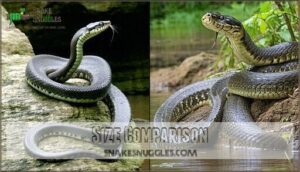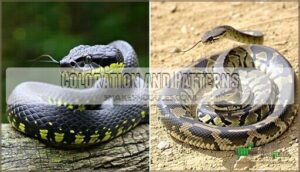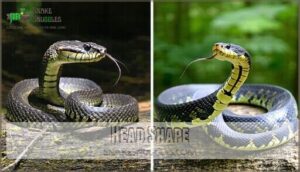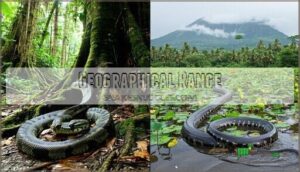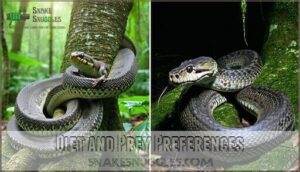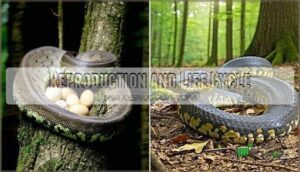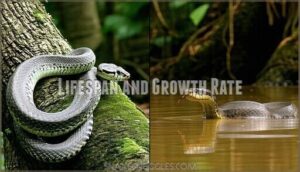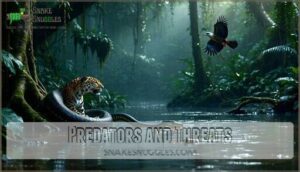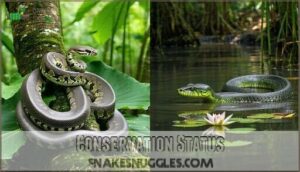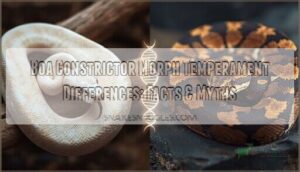This site is supported by our readers. We may earn a commission, at no cost to you, if you purchase through links.

Anacondas sport olive-green coloration with black spots, perfect for their aquatic lifestyle in South American wetlands. Boa constrictors display intricate brown saddle patterns and prefer semi-arboreal habitats in trees.
Think of anacondas as aquatic wrestlers tackling caimans in murky waters, while boas are nimble tree climbers ambushing birds and mammals. Both kill through constriction, but their hunting grounds couldn’t be more different.
These physical and behavioral adaptations reveal fascinating survival strategies that’ll surprise you.
Table Of Contents
- Key Takeaways
- Classification and Taxonomy
- Physical Characteristics
- Habitat and Distribution
- Behavior and Lifestyle
- Diet and Prey Preferences
- Reproduction and Life Cycle
- Lifespan and Growth Rate
- Predators and Threats
- Conservation Status
- Interactions With Humans
- Frequently Asked Questions (FAQs)
- Is an anaconda the same as a boa constrictor?
- Which snake can defeat anaconda?
- Are anacondas a constrictor?
- Are anacondas considered boas?
- Are anacondas part of the boa family?
- What snake is bigger than the boa constrictor?
- Does the US have anacondas?
- Which snake has a stronger bite force?
- How do their venom glands differ?
- Can boa constrictors and anacondas interbreed?
- Conclusion
Key Takeaways
- You’ll find anacondas are massive heavyweight champions – reaching up to 30 feet and 550+ pounds, compared to boa constrictors’ more manageable 6-10 feet and under 100 pounds.
- Their habitats couldn’t be more different – anacondas thrive as aquatic predators in South American wetlands, while boa constrictors excel as versatile climbers in trees and terrestrial environments across the Americas.
- You can easily distinguish them by appearance – anacondas sport olive-green coloration with black oval spots, perfect for water camouflage, while boas display intricate brown saddle patterns with tan backgrounds.
- They’ve evolved completely different hunting strategies – anacondas ambush large prey, like caimans, from underwater using their aquatic adaptations, while boas use their climbing abilities to hunt birds and mammals from trees.
Classification and Taxonomy
You’ll find that both boa constrictors and anacondas belong to the Boidae family, but they’re classified under different genera.
Boa constrictors are part of the Boa genus, while anacondas belong to the Eunectes genus, which explains their distinct physical and behavioral characteristics.
Family Boidae
Both boa constrictors and anacondas belong to the Boidae family, sharing evolutionary traits that make them exceptional constrictors.
These ancient serpents evolved millions of years ago into nature’s most powerful constricting predators.
You’ll discover these remarkable reptiles evolved sophisticated hunting mechanisms over millions of years. Boidae Evolution showcases incredible Snake Diversity within this ancient lineage.
Here are four key Boidae characteristics:
- Non-venomous constriction – They squeeze prey instead of using venom
- Vestigial hind limbs – Tiny remnants of ancestral legs remain
- Heat-sensing pits – Specialized organs detect warm-blooded prey
- Live birth capabilities – Most species give birth to live young
This Reptile Classification unites diverse constrictor snakes under one remarkable family tree.
Genus Differences
Understanding Genus Classification reveals important differences between these Boidae family members.
Boa constrictor belongs to the Boa genus, while Anaconda species fall under Eunectes.
This Species Distinction reflects their Evolutionary History – Phylogenetic Analysis shows they diverged millions of years ago.
Genetic Variation between genera explains why you’ll notice anacondas adapted for aquatic life while boas remained more terrestrial, creating distinct Snake species with different ecological roles.
Physical Characteristics
When comparing these massive constrictors, you’ll notice striking differences in their physical build and appearance.
Anacondas substantially outsize boa constrictors, with green anacondas reaching up to 30 feet and weighing 550 pounds compared to boas’ typical 10-foot length and 100-pound weight, which highlights the significant size difference between these two species, with anacondas being the larger of the two.
Size Comparison
When examining Length Differences, you’ll notice anacondas dwarf boa constrictors substantially.
Anaconda size reaches up to 27.7 feet verified, while boa constrictor size maxes at 18 feet.
Weight Comparison shows anacondas weighing over 500 pounds versus boas at 100 pounds maximum.
Girth Measurement reveals anacondas achieving 12-inch diameters compared to boas’ slimmer 14-inch circumference.
This Size Variance makes anacondas nature’s heavyweight champions.
Boa constrictors are sometimes kept as pets to provide natural rodent control in some regions.
Coloration and Patterns
Distinctive patterns help you identify these powerful constrictors at first glance. Anaconda Colors feature olive-green backgrounds with dark black oval blotches, while Boa Markings display tan or brown bases with darker brown saddle-shaped patterns.
Pattern Variation serves essential Camouflage Purpose in their respective environments.
Here are three key pattern differences:
- Anacondas showcase olive-green scales with pronounced black oval markings
- Boa constrictors exhibit tan backgrounds with brown diamond-shaped saddles
- Regional Differences create subtle variations within each species’ typical coloration
Head Shape
Two key anatomical features distinguish these serpents’ heads, making field identification straightforward.
You’ll notice anaconda snakes possess broader, flatter heads with elevated nostril placement for aquatic hunting, while boa constrictors display narrower, more streamlined profiles suited for terrestrial pursuits.
| Feature | Boa Constrictor | Anaconda |
|---|---|---|
| Snout Length | Elongated, tapered | Shorter, blunt |
| Jaw Structure | Narrow profile | Robust, wider |
| Scale Patterns | Smaller head scales | Larger head scales |
| Sensory Pits | Heat-sensing labial pits | Fewer sensory adaptations |
Habitat and Distribution
Where you find these powerful constrictors depends on their unique environmental needs and geographic origins.
Boa constrictors adapt to diverse habitats from Mexico to Argentina, while anacondas stick to South America’s wetlands where they can hunt from the water.
Boa Constrictor Habitats
You’ll find boa constrictors thriving across remarkably diverse environments thanks to their exceptional habitat diversity.
Climate influence shapes their distribution from Mexico’s arid regions to Argentina’s wetlands, while their arboreal adaptations let them excel in trees and on ground.
Here’s where boas make themselves at home:
- Rainforests – Dense canopies provide abundant prey and microhabitat preferences for humid conditions
- Savannas – Open grasslands offer excellent hunting opportunities despite human encroachment
- Semi-deserts – Surprising drought tolerance allows survival in mammal burrows during harsh periods
Anaconda Habitats
In South American Wetlands, you’ll discover anacondas thriving within Aquatic Ecosystems like swamps, marshes, and slow-moving streams.
These semi-aquatic giants inhabit the Amazon and Orinoco basins, where their anaconda habitat provides abundant prey and perfect hunting conditions.
Unfortunately, Habitat Loss and Climate Change threaten these essential environments, making Conservation Efforts essential for protecting these remarkable predators in their natural wetland homes.
Geographical Range
Across vast territories spanning multiple continents, boa constrictor and anaconda distributions reveal striking differences in range expansion and habitat overlap.
Boa constrictors inhabit regions from Central America through South America, adapting to diverse climates from rainforests to semi-arid zones, while anacondas remain confined to South American wetlands where climate influence supports their aquatic lifestyle.
Adult boa constrictors typically reach around 10 feet in length. Color variations provide effective camouflage in habitats where they reside.
- Boa constrictor range: Northern Mexico to northern Argentina
- Anaconda distribution: Amazon and Orinoco basins exclusively
- Habitat overlap: Limited to South American rainforest regions
- Introduced species: Both established in southern Florida
- Range expansion: Boas show greater adaptability across climates
Behavior and Lifestyle
You’ll notice these serpents display remarkably different lifestyles despite their shared constrictor hunting method.
While anacondas spend most of their time lurking in water waiting to ambush prey, boa constrictors lead more versatile lives as skilled climbers and ground-dwellers.
Hunting Techniques
Both species master the art of patient ambush tactics, but their hunting strategies differ dramatically based on environment.
Anacondas excel at aquatic hunting, using superior sensory perception to detect prey vibrations underwater. Their massive constriction strength allows them to overpower larger victims like caimans.
Some hunters even study specific hunting products to better understand the snake’s behavior.
- Anaconda vs boa strike speed: Anacondas launch lightning-fast attacks from water, while boas drop from trees
- Anaconda diet targets: Large aquatic mammals and reptiles requiring immense crushing power
- Boa diet focuses: Smaller arboreal prey using precise tree-based positioning
Aquatic Adaptations
While anacondas dominate aquatic environments, their specialized adaptations make them extraordinary underwater predators.
Their streamlined bodies enable efficient aquatic locomotion with remarkable water resistance capabilities and superior oxygen conservation compared to terrestrial boa constrictors.
These water-dwelling snakes possess elevated nostril placement for surface breathing during submerged hunting.
| Adaptation Feature | Anaconda Advantage |
|---|---|
| Nostril Position | Elevated, valve-like closures |
| Body Density | Neutral buoyancy control |
| Lung Capacity | Extended breath-holding ability |
| Swimming Speed | Powerful undulation mechanics |
| Pressure Tolerance | Deep-water hunting capability |
Arboreal Vs. Terrestrial Habits
Compared to anacondas, boa constrictors show remarkable Habitat Versatility and Climbing Ability. These terrestrial snakes excel at arboreal movement, making trees their second home.
Arboreal and terrestrial habitat differences include:
- Boa constrictor Branch Preference for hunting birds and small mammals
- Strong prehensile tails provide excellent Canopy Use stability
- Ground Movement patterns differ substantially between species
- Anacondas rarely venture above water level due to body weight
- Climbing Ability gives boas access to diverse prey sources
Diet and Prey Preferences
When you compare what these massive constrictors eat, you’ll discover that anacondas tackle much larger prey than their boa constrictor cousins.
While boas typically hunt birds, rodents, and small mammals, anacondas can take down capybaras, caimans, and even deer thanks to their superior size and aquatic hunting advantages.
Boa Constrictor Diet
Most boa constrictors enjoy prey variety including rodents, birds, bats, and small mammals like opossums.
You’ll find their juvenile diet starts with mice and lizards, while adults tackle larger prey.
Their hunting frequency varies – juveniles eat weekly, adults monthly.
Regional variations affect available prey, but digestion rate allows weeks between meals after consuming sizeable prey.
Anaconda Diet
Unlike boa constrictors with their varied terrestrial menu, anacondas showcase impressive aquatic hunting prowess.
You’ll find these apex predators targeting prey ranging from fish and birds to massive caimans and capybaras.
Their hunting strategy involves patient underwater ambushes, striking with lightning speed.
Large meals allow extended digestion rate periods—sometimes months between feedings.
This dietary impact supports their massive size, with prey size often reaching 50% of their body weight, demonstrating remarkable feeding efficiency.
Prey Size Differences
The prey size difference between these constrictors reveals their hunting specializations.
Boa constrictors typically tackle rodents, birds, and medium-sized mammals weighing 2-10 pounds.
Anacondas, however, can overpower massive prey like 100-pound capybaras, caimans, and even jaguars.
Understanding their hunting prowess is essential to appreciating their ecological role.
This dramatic size variation in diet composition directly reflects each species’ physical capabilities and feeding frequency patterns, with anacondas requiring fewer but substantially larger meals.
Reproduction and Life Cycle
When you’re comparing these massive constrictors, their reproductive strategies reveal fascinating differences that reflect their distinct lifestyles.
You’ll discover that anacondas and boa constrictors have evolved unique approaches to mating, pregnancy duration, and offspring production that perfectly match their aquatic versus terrestrial preferences.
Mating Behaviors
In the context of courtship rituals, you’ll notice striking differences between these snake species.
Male boa constrictors use their vestigial pelvic spurs to gently stroke females during breeding season, which occurs April through August.
Anacondas take a more competitive approach—multiple males form dramatic breeding balls around a single female, wrestling for mating rights.
Both species rely on pheromone use to locate potential mates, but their reproductive strategies differ substantially in timing and male competition intensity.
Gestation Period
When you’re comparing snake reproduction, gestation length reveals fascinating differences between these species.
Boa constrictors carry their developing young for approximately 5-8 months, while anacondas extend this period to 6-10 months.
Both species demonstrate live birth rather than laying eggs:
- Gestation Length: Anacondas require 1-2 additional months compared to boa constrictors
- Birthing Season: Environmental temperatures substantially influence timing for both species
- Parental Care: Neither species provides care after newborn size reaches independence
Neither of these points alters the fundamental fact that both boa constrictors and anacondas have unique reproductive characteristics.
Number of Offspring
Both boa constrictors and anacondas bring dozens of babies into the world through live birth.
You’ll find boa constrictors producing larger litters, typically ranging from 10 to 65 offspring per breeding cycle.
Anacondas maintain smaller but still substantial broods of 20 to 40 young.
| Species | Litter Size | Offspring Length |
|---|---|---|
| Boa Constrictor | 10-65 young | 15-20 inches |
| Anaconda | 20-40 young | 24 inches |
Both species exhibit ovoviviparous reproduction, where eggs develop internally before hatching inside the mother’s body.
Neither parent provides care after birth – the juveniles must immediately fend for themselves.
Birthing frequency occurs every 2-3 years for both species, allowing mothers time to recover their body condition.
Juvenile survival rates depend heavily on environmental factors and predation pressure.
Reproductive maturity arrives around 3-4 years for both snake species.
Lifespan and Growth Rate
You’ll find fascinating differences in how these massive constrictors age and develop throughout their lives.
While both species are long-lived reptiles, their growth patterns and maximum lifespans vary substantially based on their distinct evolutionary adaptations.
Average Lifespan
Looking at these serpentine giants reveals striking lifespan comparison differences. Boa constrictors typically live 20-30 years in captivity, while anacondas average just 10-15 years in wild conditions.
Captive vs. wild environments dramatically impact longevity through:
- Consistent veterinary care eliminating parasites and disease
- Reliable food sources preventing nutritional stress
- Protection from predators and environmental hazards
Environmental impacts and factors affecting lifespan create this disparity, with controlled settings extending both species’ aging process considerably. Proper humidity levels are essential for healthy boa growth.
Growth Patterns
Since size dimorphism kicks in early, you’ll notice female anacondas and boa constrictors dramatically outgrow males.
Juvenile growth accelerates with feeding frequency, though anaconda length increases faster than boa length.
Growth factors like temperature and prey availability influence maturity onset.
Both species continue growing throughout life, with anacondas reaching maximum size of 30 feet and 550 pounds, while snake size in boas peaks around 10 feet.
Anaconda weight surpasses most constrictors substantially.
Predators and Threats
Despite their impressive size and strength, you’ll find that both boa constrictors and anacondas face natural predators during their vulnerable juvenile stages, with jaguars, caimans, and large birds posing the greatest threats to young snakes.
Human activities present the most significant danger to adult populations, as habitat destruction, hunting for skin trade, and the exotic pet market continue to impact both species across their ranges, with human activities being a major concern.
Natural Predators
Despite their impressive size, both boa constrictors and anacondas aren’t invincible. These powerful constrictors face several natural threats that keep their populations in check.
Anaconda Predators and Boa Predators include:
- Jaguars – These apex cats are skilled snake hunters, especially targeting smaller individuals
- Birds of prey – Eagles and hawks focus on juvenile vulnerability during early life stages
- Caimans and crocodilians – These reptilian predators pose serious threats in aquatic environments
Juvenile vulnerability remains the biggest factor, as young snakes lack the size and strength of adults. Understanding prey availability dynamics is vital for comprehending snake population health. Predator adaptations like powerful jaws and hunting strategies create significant ecosystem impact, ensuring these constrictors don’t dominate their habitats unchecked.
Human Impact
Human activities pose the greatest threat to both boa constrictors and anacondas.
Habitat loss from deforestation has eliminated 20% of suitable snake ranges, while hunting pressure and the exotic pet trade remove thousands annually from wild populations.
| Threat Type | Impact on Populations |
|---|---|
| Deforestation | 20% habitat range loss |
| Pet Trade | Thousands removed annually |
| Road Mortality | High juvenile death rates |
| Persecution | Fear-based killings common |
Conservation efforts struggle against weak enforcement and invasive species problems from released pets in non-native areas like Florida.
Conservation Status
You’ll find that both species face different conservation challenges based on their habitats and human interactions.
While boa constrictors maintain stable populations across most of their range, green anacondas encounter greater pressure from habitat loss in South America’s wetland ecosystems.
Boa Constrictor Conservation
While both species face environmental pressures, boa constrictor conservation presents a complex picture.
You’ll find these snakes classified under CITES Appendix II, meaning their international trade requires permits to prevent overexploitation.
Key conservation challenges include:
- Habitat loss from deforestation and agricultural expansion across their range
- Illegal trade removing thousands annually for the exotic pet market
- Genetic diversity concerns in isolated island populations
Most mainland boa constrictor populations remain stable due to their adaptability to diverse environments.
However, island subspecies face heightened risks from habitat fragmentation and human encroachment.
Captive breeding programs help supplement wild populations, while public awareness campaigns reduce persecution by dispelling myths about these beneficial predators.
Anaconda Conservation
Throughout water and land across South America, green anaconda populations face mounting pressures from habitat loss and human persecution.
These massive serpents require extensive wetland ecosystems that continue shrinking due to agricultural expansion and urban development.
| Conservation Challenge | Impact on Anacondas |
|---|---|
| Deforestation | Destroys nesting sites |
| Water pollution | Reduces prey availability |
| Illegal hunting | Decreases population numbers |
| Climate change | Alters breeding cycles |
Current research needs focus on understanding anaconda facts about reproductive patterns and migration routes.
Sustainable practices in local communities help protect critical habitats while public awareness campaigns educate people about snake conservation importance.
Unlike boa constrictor populations, green anacondas benefit from stricter wetland protection laws that preserve their aquatic homes for future generations.
Interactions With Humans
You’ll find that humans interact with these massive constrictors in surprisingly different ways, from keeping smaller boa constrictors as exotic pets to respecting anacondas from a safe distance in folklore.
Both species have shaped human culture through myths and legends, though only one regularly finds itself in terrariums across the world, highlighting the unique relationship between humans and these constrictors.
Pet Trade
Consider these reptiles carefully before diving into exotic pet ownership.
Both boa constrictors and anacondas present unique challenges in the pet trade, though boas are more commonly kept due to their manageable size and terrestrial nature.
Key considerations for potential snake owners:
- Legal requirements – Check local pet laws and trade regulations before acquiring either species
- Space demands – Anacondas need massive enclosures with aquatic features, while boas require substantial terrestrial setups
- Feeding costs – Both consume expensive prey items, with anacondas requiring larger, costlier meals
- Safety protocols – Proper reptile care training is essential for handling these powerful constrictors safely
Proper boa constrictor care involves understanding snake habitat needs to create a suitable environment.
Cultural Significance
Beyond pet ownership, these snake species carry profound Cultural Significance across diverse societies. Boa constrictor and anaconda serve as powerful Mythical Symbols in indigenous Folklore Stories.
| Aspect | Boa Constrictor | Anaconda |
|---|---|---|
| Cultural Representations | Strength, protection, healing | Water spirits, fertility goddesses |
| Symbolic Meanings | Transformation, rebirth cycles | Primordial power, creation myths |
| Legendary Creatures | Rainbow serpent (Australia) | Yakumama (Amazonian guardian) |
In Amazonian traditions, anacondas embody Legendary Creatures like Yakumama, the massive water mother protecting rivers. Meanwhile, boa constrictors appear in Cultural Representations as symbols of renewal and wisdom.
These snake comparison reveals how different cultures interpret similar serpentine forms through unique spiritual lenses, creating rich tapestries of meaning that persist today. The study of cultural symbols is essential to understanding the significance of these creatures in various societies.
Frequently Asked Questions (FAQs)
Is an anaconda the same as a boa constrictor?
No, anacondas aren’t the same as boa constrictors.
You’re looking at two distinct species with key differences.
Anacondas grow much larger, reaching 30 feet and 550 pounds, while boas max out around 10 feet.
Anacondas live aquatically in South American waters; boas prefer terrestrial habitats across the Americas.
Which snake can defeat anaconda?
Few snakes can defeat a healthy adult anaconda.
You’d find large pythons like reticulated or Burmese pythons potentially matching anacondas in combat, though outcomes depend on individual size and circumstances rather than species superiority.
Are anacondas a constrictor?
Yes, anacondas are constrictors. They’re actually members of the boa family (Boidae) and kill prey by wrapping around it and squeezing until circulation stops, causing rapid organ failure.
Are anacondas considered boas?
Imagine this taxonomic family tree: you’re looking at distant cousins.
Yes, anacondas are technically boas, belonging to the Boidae family.
They’re scientifically classified as "water boas", making them specialized members of the broader boa family.
Are anacondas part of the boa family?
Scientifically speaking, you’ll find anacondas are indeed members of the boa family (Boidae).
They’re specifically classified as "water boas," sharing the same constricting hunting method and anatomical features as their terrestrial cousins.
What snake is bigger than the boa constrictor?
Anacondas are larger than boa constrictors. You’ll find that anacondas reach up to 30 feet and weigh up to 550 pounds, while boa constrictors typically measure around 10 feet and weigh substantially less.
Does the US have anacondas?
Native anacondas don’t inhabit the US.
However, you’ll find invasive Burmese pythons in Florida’s Everglades, and escaped pet anacondas occasionally surface.
These powerful constrictors aren’t established populations—they’re isolated incidents rather than thriving communities.
Which snake has a stronger bite force?
Anacondas typically have stronger bite force than boa constrictors due to their larger jaw muscles and broader skull structure.
You’ll find anacondas can deliver more crushing power when initially grabbing prey before constriction begins.
How do their venom glands differ?
Neither boa constrictors nor anacondas have venom glands. You’re dealing with nonvenomous constrictors that rely on powerful coiling and suffocation to subdue prey, not toxic bites for hunting success.
Can boa constrictors and anacondas interbreed?
Like two puzzle pieces from different boxes, you can’t fit these species together.
Boa constrictors and anacondas belong to separate genera (Boa and Eunectes respectively), making interbreeding impossible despite both being boids.
Conclusion
Understanding the difference between boa constrictor and anaconda is like comparing a graceful gymnast to a powerhouse wrestler.
These serpentine cousins have evolved distinct survival blueprints that showcase nature’s incredible adaptability.
You’ve discovered how size, habitat preferences, and hunting strategies create two remarkably different predators within the same family.
Whether you’re fascinated by the boa’s arboreal acrobatics or the anaconda’s aquatic dominance, both species demonstrate the remarkable diversity found in South America’s ecosystems.

